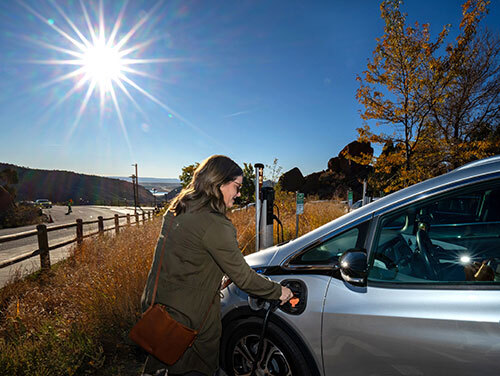Electric Vehicle Benefits and Considerations
All forms of electric vehicles (EVs) can help improve fuel economy, lower fuel costs, and reduce air quality impacts. Using electricity as a power source for transportation improves public health and the environment, and provides safety benefits, and contributes to a secure transportation system.
Batteries

The advanced batteries in electric vehicles are designed for extended life but will wear out eventually. Several manufacturers of electric vehicles are offering 8-year/100,000-mile battery warranties. Predictive modeling by the National Laboratory of the Rockies indicates that today’s batteries may last 12 to 15 years in moderate climates (8 to 12 years in extreme climates). In addition to climate, other factors impacting battery life include driving and charging patterns, battery cell chemistry and design, and the vehicle-battery-environment thermal system.
Check with your dealer for model-specific information about battery life and warranties. Although manufacturers have not published pricing for replacement batteries, some are offering extended warranty programs with monthly fees. If the batteries need to be replaced outside the warranty, it may be a significant expense. Battery prices are expected to continue declining as battery technologies improve and production volumes increase.
Costs
Although energy costs for EVs are generally lower than for similar conventional vehicles, purchase prices can be significantly higher. Prices are likely to equalize with conventional vehicles, as production volumes increase and battery technologies continue to mature. Also, initial costs can be offset by fuel cost savings and state and utility incentives. Some states and electric utilities also offer incentives, many of which can be found in the Laws and Incentives database. For more information on available incentives, connect with your local Clean Cities and Communities coalition.
Use the Vehicle Cost Calculator to compare lifetime ownership costs of individual models of electric vehicles and conventional vehicles.
Fuel Economy
Electric vehicles can reduce fuel costs dramatically because of the high efficiency of electric-drive components. Because all-electric vehicles and PHEVs rely in whole or part on electric power, their fuel economy is measured differently than that of conventional vehicles. Miles per gallon of gasoline equivalent (MPGe) and kilowatt-hours (kWh) per 100 miles are common metrics. Depending on how they are driven, today's light-duty all-electric vehicles (or PHEVs in electric mode) can exceed 130 MPGe and can drive 100 miles consuming only 25–40 kWh.
HEVs typically achieve better fuel economy and have lower fuel costs than similar conventional vehicles. For example, FuelEconomy.gov lists the 2024 Toyota Corolla Hybrid at an EPA combined city-and-highway fuel economy estimate of 50 miles per gallon (MPG), while the estimate for the conventional 2024 Corolla (four cylinder, automatic) is 35 MPG. Use the Find A Car tool on FuelEconomy.gov to compare fuel economy ratings of individual hybrid and conventional models.
The fuel economy of medium- and heavy-duty all-electric vehicles and PHEVs is highly dependent on the load carried and the duty cycle, but in the right applications, all-electric vehicles maintain a strong fuel-to-cost advantage over their conventional counterparts.
Infrastructure Availability
All-electric vehicles and PHEVs have the benefit of flexible charging because the electric grid is near most locations where people park. To safely deliver energy from the electric grid to a vehicle’s battery, an EV charging station, sometimes referred to as electric vehicle supply equipment (EVSE), is needed. Drivers can charge overnight at a residence, including multifamily housing, as well as the workplace or a public charging station when available. PHEVs have added flexibility because they can also refuel with gasoline or diesel (or possibly other fuels in the future) when necessary.
Public charging stations are not as ubiquitous as gas stations. Charging equipment manufacturers, automakers, utilities, Clean Cities and Communities coalitions, states, municipalities, and government agencies are rapidly establishing a national network of public charging stations. The number of publicly accessible charging stations in the United States reached more than 60,000 in 2024, offering more than 162,000 charging ports, according to the Alternative Fueling Station Locator. Search for electric charging stations near you.
Energy Security
The transportation sector accounts for approximately 30% of total U.S. energy needs and 70% of U.S. petroleum consumption. Using more energy efficient vehicles like hybrid and electric vehicles supports the U.S. economy and helps diversify the U.S. transportation fleet. The multiple fuel sources used to generate electricity results in a more secure energy source for the electrified portion of the transportation sector. All of this strengthens national energy security by increasing flexibility during natural disasters and fuel supply disruptions.
HEVs typically use less fuel than similar conventional vehicles because they employ electric-drive technologies to boost vehicle efficiency through regenerative braking—recapturing energy otherwise lost during braking. PHEVs and all-electric vehicles, also referred to as battery electric vehicles (BEVs), are both capable of being powered solely by electricity, which is produced in the United States from natural gas, coal, nuclear energy, wind energy, hydropower, and solar energy.